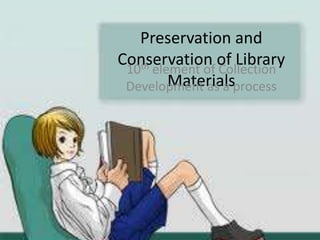
Preservation and conservation of library materials
- 1. Preservation and Conservation of Library 10th element of Collection Materials Development as a process
- 2. Questions MUST be answered
- 3. What is Preservation? • Maintenance of resources • To prevent (organic bodies) from decaying or spoiling. • To keep in perfect or unaltered condition; maintain unchanged.
- 4. What is Conservation? • Treatment of the physical items to extend their life • To repair • Preservation or restoration from loss, damage, or neglect
- 5. What are the factors that damages Library Materials?
- 6. Proper Handling Using too narrow/too shallow shelf will result in items being knocked off and damaged. Foreedge shelving undue strain on the binding.
- 7. Environmental Control • Temperature cycling is damaging. For every rise of 1, book papers deteriorate twice as fast. • Humidity and heat combine to accelerate deterioration from paper acidity. • The ideal range for microforms is 70 +/-5℉ with humidity at 40% +/-5%. Nitrate-based motion picture film must be stored below 55℉ but can tolerate humidity up to 45%. Videotapes do best at 65℉ +/-5℉ and no more than 40% humidity. Audiodiscs (LPs, 45s, and so forth) can handle temperatures up to 75℉ and 50% humidity. However, the upper limits for audiotapes are 70℉ and 45% humidity. Electronic me4dia (CDs and DVDs) are best store4d at temperature between 14℉ and 73℉, with a relative humidity between 20 and 50%. However, lower relative temperatures only slow the process but can’t stop it.
- 9. • Lighting (natural/artificial) influences preservation. Artificial lighting when close to mate4rial there can be significant temperature differentials from button to the top shelf in a storage unit. • Windows and sunlight generate heat as well, and they create miniclimates that resulted to the damaging of the materials. • Non-print materials are more sensitive in natural lighting (ultraviolet radiation) like fluorescent light. • Sulfur dioxide is a major air pollutant and a concern for library preservation program, because it combines with water vapor to form sulfuric acid that makes the book paper deteriorate. • Silverfish, cockroaches, termites, larder beetle larvae (book worm) and book lice eat the entire papers of the book.
- 10. Security Lost library materials such as books, films, etc., are one of the major problems in preservation of the library materials.
- 11. Disaster An expected natural/accidental disaster may lost the library materials. Natural disasters such as earthquake are cannot easily to prevent while accidental disaster such as fire are preventable. The prevention of those disasters may be depending upon the knowledge of the librarian in how he/she can handle it.
- 12. How we can prevent those factors? • Buying adjustable storage units provides the library a measure of flexibility. • Proper supports and book-ends help to keep the materials in good order. • The Library of Congress recommends a temperature of 55℉ in book storage areas and a maximum of 75℉ in reading areas.
- 13. • Do not use pesticides! Because it could create pollution problems. To control this, is to keep foods and drinks out of the library and keeping humidity as low as possible so that insects cannot multiply. • People-based security and electronic systems are required in the library to prevent cases of theft and mutilation.
- 14. The following are the basic steps to take in preparing a disaster plan: 1. Study the library for potential problems. Often institution’s risk management officer (insurance) is more than willing to help in that assessment. 2. Meet with local fire and safety officers for the same purpose. 3. Establish a planning team to develop a plan. This team may become the disaster-handling team. 4. Establish procedures for handling each type of disaster and, if appropriate. Form different teams to handle each situation.
- 15. 5. Establish a telephone calling tree, or other fast notification system, for each disaster. A telephone tree is a plan for who class in a certain order. 6. Develop a salvage priority list for the collections. If necessary, mark a set of floor plans and include them in the disaster planning and response manual. Most plans do not have more than three levels of priority: first priority is irreplaceable or costly materials; second is materials that are expensive or difficult to replace’ and third is the rest of the collection. Establishing priorities can be a challenge for planners, because everyone has some vested interest in the subject areas with he or she works.
- 16. 7. Develop a list of recovery supplies the library will maintain onsite (e.g., plastic sheeting and butcher paper). 8. Include a list of resources—people and companies that may assist in the recovery work.
- 17. How we conserve Library Materials? • The physical features of an original artifact— paper, ink, binding, sewing structure, and cover--hold matchless information for the researcher. They establish a connection with the past that cannot be established through electronic access alone.
- 18. • Thus the main object if conservation is to keep library and archival materials in their original format as long as possible. Library and archival materials can be preserved through remedial treatment of individual materials (flattening, book and paper repair, binding), treatment if an entire collection (mass deacidification, fumigation), and stabilization (surface cleaning, new containers, protective enclosures). Conservation methods and materials should not damage library materials.
- 19. • Conservation also involves prudent collection management. For example, sound techniques for binding materials such as periodicals and unbound monographs are important, because the way these materials are bound determines how long they will last and how easily the contents can be accessed. While in the past, highly-decorated bindings were produced as a part of the rebinding process, the primary object of conservation is not cosmetic; indeed, the cosmetic approach can often compromise good conservation practice.
